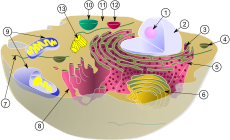
Back Mitochondrium Afrikaans Mitocondria AN ميتوكندريون Arabic Mitoxondri Azerbaijani Мітахондрыя Byelorussian Митохондрия Bulgarian মাইটোকন্ড্রিয়া Bengali/Bangla Mitokondrienn Breton Mitohondrija BS Mitocondri Catalan



(1) Nucleolus
(2) Nucleus
(3) Ribosomes
(4) Vesicle
(5) Rough endoplasmic reticulum (ER)
(6) Golgi apparatus
(7) Cytoskeleton
(8) Smooth ER
(9) Mitochondria
(10) Vacuole
(11) Cytoplasm
(12) Lysosome
(13) Centrioles within centrosome
Mitochondria [1] (sing. mitochondrion) are organelles, or parts of a eukaryote cell. They are in the cytoplasm, not the nucleus.
They make most of the cell's supply of adenosine triphosphate (ATP), a molecule that cells use as a source of energy. Their main job is to convert energy. They oxidise glucose to provide energy for the cell. The process makes ATP, and is called cellular respiration.[2] This means mitochondria are known as "the powerhouse of the cell".[3]
In addition to supplying cellular energy, mitochondria are involved in a range of other processes, such as signalling, cellular differentiation, cell death, as well as the control of the cell division cycle and cell growth.[4]
- ↑ single = 'mitochondrion'; from Greek mitos, a thread + khondrion, granule
- ↑ Henze K. & Martin W. 2003. Evolutionary biology: essence of mitochondria. Nature 426: 127–8.
- ↑ "The Powerhouse of the Cell". PBS LearningMedia. Retrieved 2017-12-03.
- ↑ McBride H.M; Neuspiel M. & Wasiak S. (2006). "Mitochondria: more than just a powerhouse". Curr. Biol. 16 (14): R551–R560. doi:10.1016/j.cub.2006.06.054. PMID 16860735. S2CID 16252290.
{{cite journal}}: CS1 maint: multiple names: authors list (link)